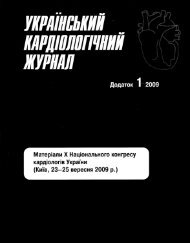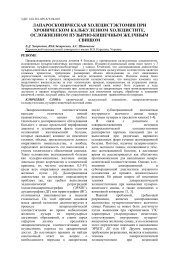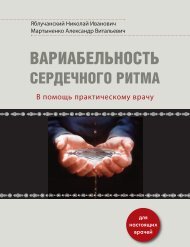мÑнÑÑÑеÑÑÑво оÑвÑÑи Ñ Ð½Ð°Ñки, Ð¼Ð¾Ð»Ð¾Ð´Ñ - ÐедиÑний ÑакÑлÑÑÐµÑ ...
мÑнÑÑÑеÑÑÑво оÑвÑÑи Ñ Ð½Ð°Ñки, Ð¼Ð¾Ð»Ð¾Ð´Ñ - ÐедиÑний ÑакÑлÑÑÐµÑ ...
мÑнÑÑÑеÑÑÑво оÑвÑÑи Ñ Ð½Ð°Ñки, Ð¼Ð¾Ð»Ð¾Ð´Ñ - ÐедиÑний ÑакÑлÑÑÐµÑ ...
Create successful ePaper yourself
Turn your PDF publications into a flip-book with our unique Google optimized e-Paper software.
Харківський національний університет<br />
імені В.Н. Каразіна<br />
Медичний факультет<br />
Актуальні питання сучасної медицини<br />
CHANGES OF THE HYPOTALAMIC-PITUITARY-THYROID SYSTEM DUE TO<br />
BURN INJURY<br />
I.A. Bogdanov<br />
Department of Pathophysiology<br />
M. Gorky Donetsk National Medical University<br />
Scientific adviser – M.D., Professor, G.K. Krivobok<br />
Relevance of the topic. In recent years there has been an increasing trend in cases of burn<br />
injuries in the industrial regions of Ukraine. Burn injury is one of the main reasons for the<br />
increase of mortality and disability, and therefore is not only medical but also serious social<br />
problem.<br />
The aim of the study. The study of the functional state of hypothalamic-pituitary-thyroid<br />
system (HPTS) in rats receiving burn an open flame.<br />
Materials and methods. Was developed to model dose of thermal burns an opened flame in<br />
the regulation of exposure, the flame temperature and area burned. The experiments were<br />
performed on white male rats nonlinear weighing 200-250g in compliance with the norms and<br />
principles of the European Convention for the Protection of Vertebrate Animals. Rats were<br />
divided into two groups: one – intact, the second – the control, in which the simulated thermal<br />
burn 5% of the body open flames (propane gas, the combustion temperature of approximately<br />
1800 0 C) at a distance of 15 mm and an exposure time of 3s under ether anesthesia. Blood<br />
was collected in a test tube to determine the concentration of thyrotropin (TSH),<br />
triiodothyronine (T 3 ) and thyroxine (T 4 ), after which it was centrifuged. Determination of<br />
hormone levels was performed using radioimmunoassay and ELISA methods.<br />
Results. The level of hormones in plasma of rats from both groups (intact and control) was<br />
investigated in an hour, day and three days after the burn. TSH (mIU / L): 0.407, 0.165 and<br />
0.187, respectively, in intact rats - 0.148. The content of T 3 (pmol /L): 2.308, 1.605 and 3.070,<br />
respectively; intact rats - 2.687. The content of T 4 (pmol / L): 87.32, 60.94 and 59.39,<br />
respectively, in intact rats - 41.21.<br />
Conclusions. Inhibition of TSH secretion is due to the fact that high concentrations of<br />
circulating thyroid hormones reduce the sensitivity of receptors adenohypophyseal TSH-cells<br />
to tireoliberin. This explains the drop in the level and points to the restoration of<br />
neurosecretory process for the next day after the injury. Rapid elimination of tireoliberin from<br />
the bloodstream after initiated by activation of the central link HPTS warns hyperactivation<br />
thyroid system. Hyperactivation also prevents long-term increase in the concentration of T 4 in<br />
blood plasma, which, according to the principle of feedback, inhibits the secretion of TSH in<br />
the pituitary gland. Confirms the decrease in activity HPTS and the fact that the very next day<br />
after the burn has been reduced conversion of T 4 to T 3 and tissue metabolism of thyroxine, as<br />
evidenced by a significant decrease in the level of T 3 . On the third day after injury HPTS<br />
indicators of activity were not significantly different from that of the intact group. It can be<br />
concluded that the need for thyroid hormone and tissue metabolism in early postburns period<br />
decreased due to the fact that in a post-traumatic hypoxia essential metabolic reaction is to<br />
save intracellular energy, rather than a general enhancement of metabolism, which is just<br />
driven by thyroid hormone. Thus, the central and peripheral units HPTS nonspecific, along<br />
- 17 -





